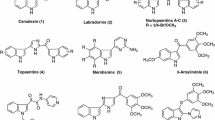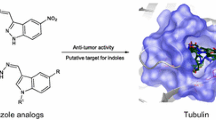Abstract
A series of triaryl-substituted hydrazones as structural acyclic prototypes were synthesized and screened for anti-proliferative activity against breast (Michigan cancer foundation-7 and MD Anderson metastatic breast-231) and uterine cancer (Ishikawa) cell lines. Two compounds were found to be the most active, 5e showed the maximum inhibition of both functional estrogen receptor containing Michigan cancer foundation-7 cells (IC50: 7.8 µM) and Ishikawa cells (IC50: 7.3 µM) whereas, compound 5i was selectively most active against ER-negative MD Anderson metastatic breast-231 cells (IC50: 4.7 µM). The inhibitory effect of 5e in breast cancer and uterine cancer cells was due to ER antagonistic action, also supported by molecular docking studies.




Similar content being viewed by others
References
Agatonovic-Kustrin S, Turner JV (2008) Molecular structural characteristics of estrogen receptor modulators as determinants of estrogen receptor selectivity. Mini Rev Med Chem 8:943–951
Kumar P, Narasimhan B (2013) Hydrazides/hydrazones as antimicrobial and anticancer agents in the new millennium. Mini Rev Med Chem 13:971–987
LaFrate AL, Gunther JR, Carlson KE, Katzenellenbogen JA (2008) Synthesis and biological evaluation of guanylhydrazone coactivator binding inhibitors for the estrogen receptor. Bioorg Med Chem 16:10075–10084
Morgan LR, Thangaraj K, LeBlanc B, Rodgers A, Wolford LT, Hooper CL, Fan D, Jursic BS (2003) Design, synthesis, and anticancer properties of 4,4’-dihydroxybenzophenone-2,4-dinitrophenylhydrazone and analogues. J Med Chem 46:4552–4563
Pandey J, Pal R, Dwivedi A, Hajela K (2002) Synthesis of some new diaryl and triaryl hydrazone derivatives as possible estrogen receptor modulators. Arzneimittelforschung 52:39–44
Shankar R, Chakravarti B, Singh US, Ansari MI, Deshpande S, Dwivedi SKD, Bid HK, Konwar R, Kharkwal G, Chandra V, Dwivedi A, Hajela K (2009) Synthesis and biological evaluation of 3,4,6-triaryl-2-pyranones as a potential new class of anti-breast cancer agents. Bioorg Med Chem 17:3847–3856
Shiau AK, Barstad D, Loria PM, Cheng L, Kushner PJ, Agard DA, Greene GL (1988) The structural basis of estrogen receptor/coactivator recognition and the antagonism of this interaction by tamoxifen. Cell 95:927–937
Stauffer SR, Coletta CJ, Tedesco R, Sun J, Katzenellenbogen JA (2000) Pyrazole ligands: structure-affinity/activity relationships and estrogen receptor-alpha-selective agonists. J Med Chem 43:4934–4947
Stauffer SR, Huang YR, Aron ZD, Coletta CJ, Sun J, Katzenellenbogen BS, Katzenellenbogen JA (2001) Triarylpyrazoles with basic side chains: development of pyrazole-based estrogen receptor antagonists. Bioorg Med Chem 9:151–161
Sun J, Meyers MJ, Fink BE, Rajendran R, Katzenellenbogen JA, Katzenellenbogen BS (1999) Novel ligands that function as selective estrogens or antiestrogens for estrogen receptor-alpha or estrogen receptor-beta. Endocrinology 140:800–804
Singh US, Shankar R, Yadav GP, Kharkwal G, Dwivedi A, Keshri G, Singh MM, Moulik PR, Hajela K (2008) Synthesis and structure guided evaluation of estrogen agonist and antagonist activities of some new tetrazolyl indole derivatives. Eur J Med Chem 43:2149–2158
Acknowledgements
The authors, RS and USS are grateful to CSIR for Senior research fellowships and to the Ministry of Health & Family Welfare for financial assistance for the biological screening of compounds. All the authors are thankful to Sophisticated Analytical Instrument Facility for spectroscopic analyses of the pure compounds.
Author information
Authors and Affiliations
Corresponding author
Ethics declarations
Conflict of interest
The authors declare that they have no competing interests.
Rights and permissions
About this article
Cite this article
Shankar, R., Rawal, R.K., Singh, U.S. et al. Design, synthesis and biological evaluation of hydrazone derivatives as anti-proliferative agents. Med Chem Res 26, 1459–1468 (2017). https://doi.org/10.1007/s00044-017-1866-1
Received:
Accepted:
Published:
Issue Date:
DOI: https://doi.org/10.1007/s00044-017-1866-1




